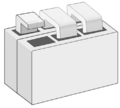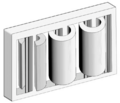Basics:Transformer Theory: Difference between revisions
No edit summary |
|||
| Line 15: | Line 15: | ||
In Figure 2, the windings are the concentric portions and the white solid portions refer to the metallic part of a transformer (laminations), which either surround the windings (shell type) or where the windings surround the core (core type). The windings are normally made of electrolytic grade copper and the metallic parts are made of steel (usually special steel called lamination steel). The metallic part linking the windings is referred to as the magnetic core of a transformer. In these transformers the source will be connected to just one winding only, which is termed as the primary winding. The voltage will be induced magnetically through the magnetic core linking the flux in the core with the other winding (called the secondary winding), since it derives its power from the primary winding. | In Figure 2, the windings are the concentric portions and the white solid portions refer to the metallic part of a transformer (laminations), which either surround the windings (shell type) or where the windings surround the core (core type). The windings are normally made of electrolytic grade copper and the metallic parts are made of steel (usually special steel called lamination steel). The metallic part linking the windings is referred to as the magnetic core of a transformer. In these transformers the source will be connected to just one winding only, which is termed as the primary winding. The voltage will be induced magnetically through the magnetic core linking the flux in the core with the other winding (called the secondary winding), since it derives its power from the primary winding. | ||
= References == | |||
Revision as of 08:48, 25 September 2023
Transformer Theory
Transformer is an essential device in electrical AC power distribution system, which is used to transform AC voltage magnitudes of any value obtained from a source to any desired value for the purpose of distribution and/or consumption. The development of power transformer dates back to 19th century. The main feature of a transformer is its constant VA rating whether referred to its primary side or the secondary side. With VA being constant (V refers to the voltage magnitude and A refers to the current magnitude in a transformer winding), it is possible to get a higher V with lower A or a lower V with a higher A, by choosing suitable ratio for the transformer.
The major benefit of such a device is its ability to take in the high current produced at relatively low voltage from the electrical generators and transform this power at a higher voltage level with lower current. This ensures that the power generated in the order of several megavolt amperes (MVA) is being transmitted at low current magnitudes in a cable of practical dimensions over very long distances. Today’s transmission and distribution systems are heavily dependent upon this technology and transformers are used extensively throughout the world.
Standard Transformer
A standard transformer typically consists of a pair of windings, primary and secondary linked together by a magnetic core. The windings can be connected in any of the following types, which in turn decides to which category a transformer belongs. There are two basic types of the transformer viz., (a) shell type and (b) core type. These are illustrated in Figure .
In Figure 2, the windings are the concentric portions and the white solid portions refer to the metallic part of a transformer (laminations), which either surround the windings (shell type) or where the windings surround the core (core type). The windings are normally made of electrolytic grade copper and the metallic parts are made of steel (usually special steel called lamination steel). The metallic part linking the windings is referred to as the magnetic core of a transformer. In these transformers the source will be connected to just one winding only, which is termed as the primary winding. The voltage will be induced magnetically through the magnetic core linking the flux in the core with the other winding (called the secondary winding), since it derives its power from the primary winding.



